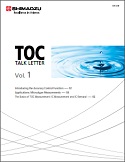Total Organic Carbon Analysis
Total Organic Carbon Analysis
A total organic carbon(TOC) analyzer is an analytical instrument that measures the total amount of organic carbon contained in water. It is used for quality control of public drinking water, control and evaluation of pharmaceutical manufacturing processes , and a wide variety of other applications.
Shimadzu is one of the world’s leading manufacturers of total organic carbon (TOC) analyzers. Our TOC analyzers boast a high level of detection sensitivity, making it suitable for a variety of applications for the environmental and pharmaceutical industries.
We offer a complete TOC instrument lineup, including our TOC-L series, which feature the highest level of detection sensitivity available by using the combustion catalytic oxidation method; the TOC-4200 on-line water quality analyzer, which supports a wide range of samples and boasts an advanced operability; and our compact eTOC series on-line TOC analyzer, perfect for ultra-pure water measurement.
Learn more about our full lineup and a variety of software and consumables below.




